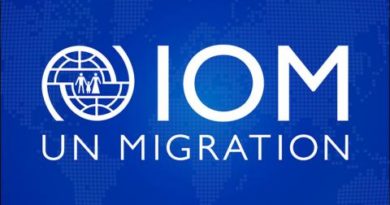Demarcation of State Boundaries As A Significant Element Of Improving Border Security
State boundaries delimitation and demarcation are important for defining the territories of states, state sovereignty and territorial integrity. The territory of a state enclosed by a precisely defined state border is still a distinctive feature of state sovereignty. Regulated state borders are important part of the relations between neighboring countries. It enhances trust, promotes cooperation and improves border security.
A well-known fact is that all state borders are to be demarcated and set up with agreements between the countries or duly marked and defined. According to the European practice, the borderline, as a rule, is drawn in three stages: the first stage implies approval of an international act of delimitation; the second stage is the demarcation done by the Joint Committee of the two countries; and the third stage consists of precise designation of the border.
The delimitation of international borders is a diplomatic-expert activity of the parties to the agreement, which should decide on the extension of the border on the basis of mutual trust and on the basis of reliable evidences, which are acceptable to both contracting parties.
Regarding the European practice in this area, the European Commission has no jurisdiction over the border demarcation process. For candidate countries there is no acquis communautaire relating to border issues and no methodology for tracking progress in this field. However, regional cooperation and good neighborly relations are considered to be “an essential part of the process of integrating with the European Union” The demarcation of the border line between the countries is of high importance for the peace and safety, and shall contribute to the retaining of the stability, also shall confirm the determination for solving the problems peacefully and shall reaffirm the principle of invariability of borders.
Among important steps of the process of building and preparing a negotiating team for the process of delimitation are required expertise, clear mandate and team dynamics, negotiating briefs, support services and access to information.
Demarcation represents the next phase of the process envisaged under the Agreement when the demarcation teams are assigned the task of transferring the delimitation directly on to the ground. National governments should ensure participation of local people from all groups in demarcation processes and take into account their views on where borders and checkpoints should lie. A number of delimited borders are not demarcated for many reasons, but in general maximum efforts must be exerted to demarcate the border where this is possible.
Border documentation – it is necessary to produce border documentation consisting of descriptions of the location of the border markers/pyramids and the spreading of the border line, outlines/drawings describing the location of each boundary pyramid and photos of the pyramids.
The delimitation and demarcation of the international border will not give a full result if in the long term the parties do not adopt provisions for the protection and maintenance of the border. The work of the Joint Commissions for the maintenance and renewal of the border line never ends. Periodically, every few years, the boundary line and boundary markers should be renewed.
A large number of countries that gained their independence are facing unresolved borders with their neighbors. There is a real danger that as states consolidate their internal positions and begin to integrate as international entities, they will begin to face certain minor or major problems due to existing and unresolved border issues, such as a border that is not demarcated.
Given that unresolved border disputes have the potential to escalate and cause more serious problems, it is recommended that the affected states seek international expertise and assistance on how to resolve border disputes.
By Olahus, CC BY-SA 3.0, https://commons.wikimedia.org/w/index.php?curid=4392089
Former Yugoslavia
In the Balkans, the borders were established at the beginning of the last century and corrected by the outbreak of the Second World War, but they were once again important with the dissolution of Yugoslavia.
All the states created by the dissolution of Yugoslavia have taken over the state borders with the neighboring countries of Yugoslavia without any dispute. Yugoslavia, while having strictly defined borders with other countries, did not have precisely marked or defined borders among its constituent parts. Although it seems that the process will be relatively simple and the administrative borders will become state borders, it was not the case. After more than 30 years since the former Yugoslavia began to disintegrate, there are borders whose delimitation is not even started and has brought various challenges. Some borders cannot be agreed because of the lack of a political climate between neighbors and some because of the different positions where the border lies.
All countries from the South-Eastern Europe region must jointly work for further development and progress. The same applies to the cooperation in the area of the mutual boundaries. Borders must be stable. The delimitation and demarcation of state borders are fundamental for stability. The borders should be well established to become invisible in the future within the EU and the Schengen area.
Additional benefit of the border regulation process is some kind of test of the capacity of the countries to mutually solve bilateral issues without major foreign interference, test the political stability of the countries and good-neighborly politics and to finish the process of border consolidation in the Western Balkans in order to secure that there will be no border revisions.
The Republic of North Macedonia
The Republic of North Macedonia is the first country out of the former Yugoslavia to legally regulate its boundaries. The successful demarcation of its northern border included the country to the family of the countries with completely regulated, internationally recognized and demarcated borders.
The process of delimitation and demarcation of the state border between the Republic of Macedonia and Serbia and Montenegro (the names of the states when delimitation was made) was specific for a number aspects and the most significant ones are the following:
- Demarcation took place between two countries which were part of a former common country and between which never existed precisely defined borderline;
- The specific situations and transformations in Serbia and Montenegro;
- The situations in Kosovo and the unsettled status in particular;
- The ethnic tensions in the Republic of Macedonia which took place immediately after the Agreement for borders was signed etc.
The demarcation and the designation of the site of the state border between the Republic of Macedonia and Serbia and Montenegro was fulfilled on the basis of an Agreement between the Republic of Macedonia and the Federal Republic of Yugoslavia for extension and description of the state border, signed in Skopje on 23 February 2001 after four-year negotiations about the delimitation of the two countries.
Bearing in mind the importance of similar Agreements which do not allow mistakes or improvisations, have unlimited term of validity and are irrevocable, the members of the Joint Committee tried hard to fulfill the task. The actuality and the significance of the problem, which required solution within the shortest term, and the public pressure contributed to the accelerated tempo and the increased responsibility of the members of the Committee as immediate creators of closing the most important matter between the two neighboring countries.
The Joint Committee agreed upon the extension of the state border based on the relevant documentation of the border extension. According to the international practice for state borders to extend along natural objects, in some places, the borderline has small deviations from its description in the documents, especially of some peaks and dominant hills. For pragmatic reasons, the whole length of the borderline was divided into six border sectors and for the same reasons it was accepted that each of the countries would be responsible for the works at three border sectors.
Border demarcation between Macedonia and Kosovo started during 2008. The specific character of the demarcation was accompanied with some tensions because traditionally neighboring settlements with inhabitants from the same ethnic group found themselves at the opposite sides of the border. In some cases, with the retreat of the borderline, some settlements remain in one of the countries, whereas part of their farms, roads, captivated springs, streams, water reservoirs etc., remain on the opposite side of the border.
Border demarcation commission between Macedonia and Kosovo, was based on the document of Marti Ahtisaari who worked on the proposal for the solution of Kosovo’s status. The mixed commission for demarcation border was formed and has continued the working according to the signed Protocol on April 18th 2008 in Skopje.
The demarcation of the Macedonian-Kosovo border began with the installation of a border pillar on the Macedonian-Albanian-Kosovo border on June 30, 2008 in the shape of a three-sided border pyramid.
The demarcation of the border between Macedonia and Kosovo with a length of about 173 km was effectively completed in less than a year, although it took place under political pressure, dissatisfaction of the border population and in conditions of mined parts of the border area.
With the completion of the demarcation of the border between the Republic of Macedonia and Serbia in 2006 and the demarcation of the border between the Republic of Macedonia and the Republic of Kosovo in 2009, the processes of delimitation and demarcation of the international borders of the Republic of Macedonia were completed. Macedonia remains the only country from the former Yugoslav republics that has completed the demarcation of all its borders.
Macedonia as a country has shown that, although relatively small, it has the capacity to deal with such serious processes as the delimitation and demarcation of state borders. In contemporary Europe, there are not many examples from which experiences can be used, so the experts who participated in the delimitation and later in the demarcation with Serbia and Kosovo can be used and can help and transfer their experiences and knowledge in processes of delimitation and demarcation of any border in the world. Good neighbors require good borders, and good borders require good and experienced experts.
By Mile Milenkoski, Border expert




